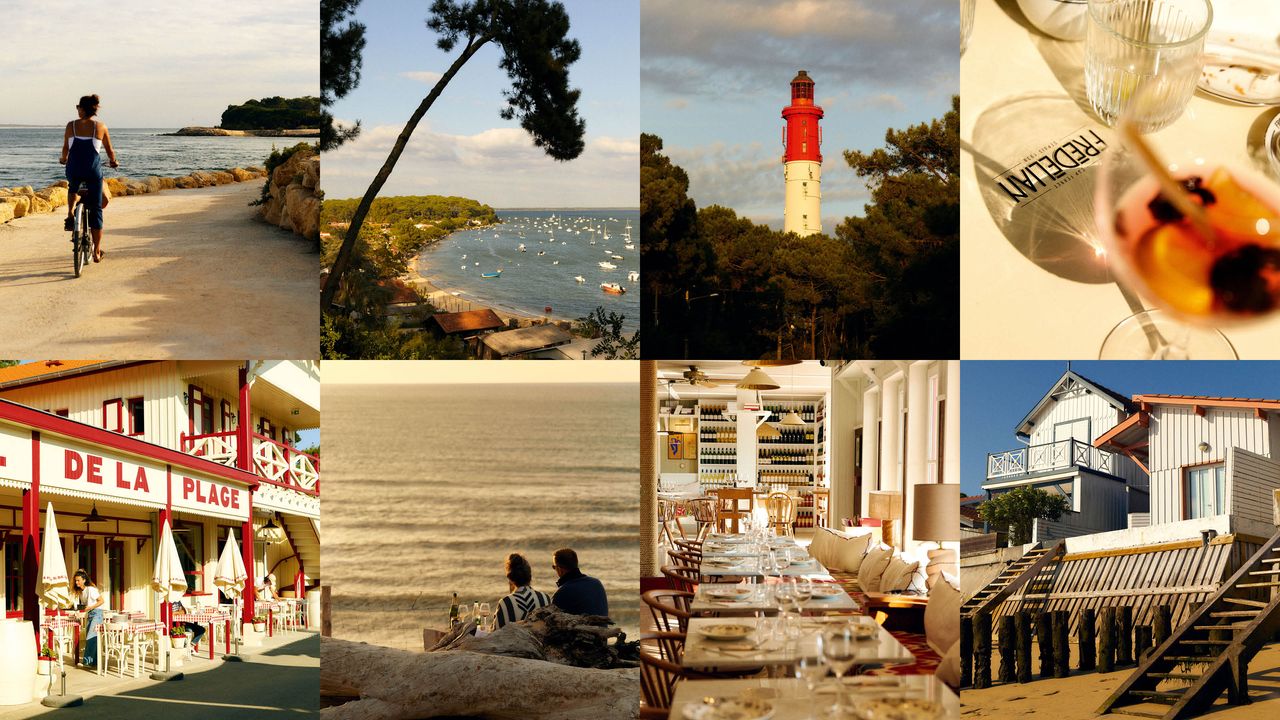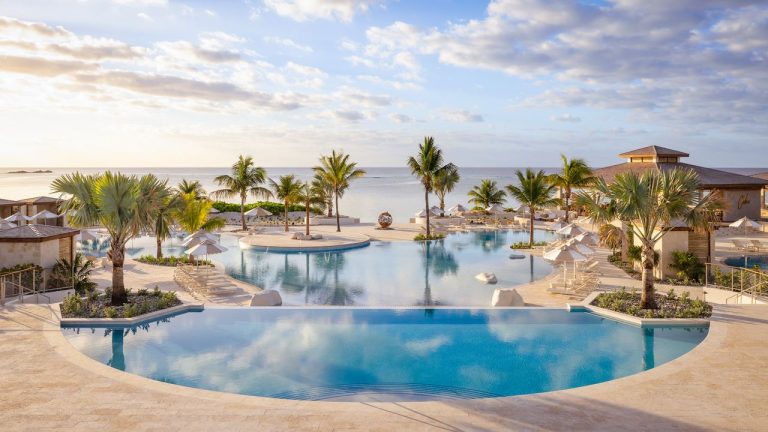I arrived on a windswept night, driving down the peninsula on a single sliver of road through a forest of pines, their scent drifting inside the car. That fresh, earthy smell became the signature of Cap Ferret. Though Bordeaux is less than a couple of hours from London, the place felt far away—at times like Cape Cod or New Zealand—because of a pleasant absence: fewer signs of humanity the further I went, and a horizon that felt to expand as the land sloped toward the sea. Cap Ferret’s value isn’t in pearls but in oysters; its pleasures are the spray of the surf and the quirks of its landscape. And while its name resembles the glamorous Cap-Ferrat on the Côte d’Azur, the two places could not be more different.
I stayed in Villa de la Pointe, a white wooden “cabane” whose modest exterior hides a high-raftered interior of rattan and bamboo, tiled floors opening onto a pool and a pétanque court. That easy, unforced elegance is everywhere on the cape: a place more concerned with how things are than how they look.
The cape itself is a narrow tongue of land pointing into the Atlantic, dividing two coastal worlds: the calm, tide-governed bay on one side and the wild ocean on the other. That geography gives rise to microclimates and different kinds of beaches within miles—or even yards—of each other. Around the village of Cap Ferret the mood is convivial and villagey; head west toward the ocean and things get surfy and bohemian. A 20-minute bike ride brought me to Plage du Truc Vert, a vast, wild sandy beach reminiscent of Australia’s Byron Bay, stretching almost uninterrupted for miles and frequented by young surfers and the occasional relic of the Atlantic Wall. I found stretches where no one else was visible, a bright white vista to the horizon.
A short boat ride across Arcachon Bay leads to Dune du Pilat—a luminous, undulating dune that seems almost mirage-like, a slice of the Sahara pressing up against the green village of Pyla‑sur‑Mer. The dune, formed over millennia, creeps inland with the wind, swallowing forest at a slow, steady pace. Nearby, La Coorniche, a Philippe Starck–designed hotel, offers immaculate staff in white suits and views across the water with the dunes rising behind—an elegant counterpoint to the rawness of the sand.
Locals constantly invoked one man: Benoît Bartherotte, a prominent figure whose life reads like a small drama of friendships and fallings-out with figures in French cultural life. He owns La Pointe, the cape’s prized tip where bay meets ocean. Though French law limits beach privatization, Bartherotte saved the tip from erosion in the 1980s using inventive engineering. His own home is a weathered beach shack, full of faded mementos and his grandchildren’s drawings. “I am attached to this land,” he told me. “The sky and the sand. You can never forget that you are living on a planet when you’re here.” His mother’s summation—“Cap Ferret is like a holiday from the holiday”—captures the place’s quiet detachment.
That detachment is part of the charm. The area seems to embody Jean‑Pierre Claris de Florian’s advice: “Pour vivre heureux, vivons cachés”—to live happily is to live hidden. What I loved most wasn’t the designer hotels or grand villas, but the ambient calm: long, slow mornings, contemplative moments watching sand curves and sailboat masts, and a communal laxness about time. At Frédélian, an Art Deco café open since 1939, the co‑owner shrugged when I asked if they stayed open year-round: “Depends how busy it is.” That casual tempo felt ubiquitous.
To the north is L’Herbe, an oyster‑farming village with whitewashed wooden cabins and brightly painted shutters. Here the menu is simple—white wine, oysters, pâté, shrimp, sea snails—but the produce is exceptional. The cape’s unique ecosystem, where fresh and saltwater mix and phytoplankton flourishes, plus dramatic tides, produces oysters prized across France—arguably the world. Watching farmers haul oysters out of the bay and shuck them at lightning speed, then pair them with a crisp local white, is an immersive, elemental experience.
I met Estelle, a young oyster farmer at Le Monte à Bord, who explained the challenges facing her trade. Subsidized housing exists for oyster workers, she said, but it’s insufficient; many younger farmers struggle with unstable living arrangements and little space to grow into. The future of the craft depends on supporting people like her.
A brighter example is La Cabane D’Hortense, run by Khalid Zamrani. Sitting in a grove above the Conche du Mimbeau bay, the shack has a relaxed, inclusive vibe. Zamrani—whose father was an imam and who grew up mixing cultures—started as a dishwasher at Chez Hortense and rose through the ranks. He embraced the café culture where staff and patrons blur roles: he jokes with regulars, serves with warmth, and fosters a “zen space” where hierarchy doesn’t matter. He farms oysters, serves them affordably, and made a place where people come for the food, and stay for the atmosphere.
My final night coincided with the village fête, the informal closing party of the high season. Locals and regulars gathered to drink, dance, and celebrate the summer’s end. On the dance floor among generations, to the sound of surf and Boney M, I found myself part of the motley community I had glimpsed all week—farmers, restaurateurs, villa owners—forgetting, briefly, that I had to return home.
Where to stay
– Le Collectionist Villas: A range of tailor‑made villas with optional chefs and staff. Villa de la Pointe sits near La Pointe and the beaches; Villa Dorea is more stylish and hidden; Villa Omnia offers extensive amenities including a library, gym, and a private path to the ocean.
– La Coorniche: Philippe Starck–designed hotel in Pyla‑sur‑Mer with panoramic views, an infinity pool, and seafood‑forward dining. Rooms spread across the main house and oyster‑shack–inspired lodges.
– Hôtel de la Plage: In L’Herbe, this restored former pine‑resin workers’ dormitory offers 12 colorfully decorated rooms close to oyster farms, and a café serving meat and vegetable dishes as well as seafood.
Where to eat
– Oysters in L’Herbe: The most authentic food experience is in the oyster shacks—white cabins with colorful shutters serving oysters straight from the bay. Le Monte à Bord overlooks Arcachon Bay.
– Chez Hortense: Known for moules‑frites and fresh bay catches, with a terrace near La Pointe; casual staff, impeccable views, and excellent food.
– La Cabane D’Hortense: Khalid Zamrani’s popular spot serving half‑dozen oysters with rosé at modest prices and a convivial “zen” atmosphere.
– Cap Ferret Market: The traditional market in Lège Cap‑Ferret has about 130 stalls selling produce, artisanal goods, clothes, flowers, and local pastries such as the dune blanche from Chez Pascal bakery—ideal followed by tapas and a glass at Le Bistrot de Peyo.
– Mayzou: For a younger crowd and adventurous cooking, chef Juliette Lacroix‑Wasover offers daily‑changing dishes with pan‑Asian influences, five‑spice duck, fish tacos, and inventive desserts.
Cap Ferret is a peninsula of contrasts: refined and rough, communal and private, timeless and shifting. Its allure lies not in ostentation but in elemental things—the sky, the sand, the sea—and a community that treats life here as a slow, well‑kept secret.




